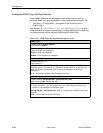
Configuration
3-46
9664-A2-GB20-00
March 2000
Table 3-14. SNMP Traps and Trap Dial-Out Options (3 of 5)
Link Traps
Possible Settings: Disable, Up, Down, Both
Default Setting: Both
Determines whether SNMP linkDown or linkUp traps are sent to the currently configured
trap manager(s). A linkDown trap indicates that the unit recognizes a failure in one of
the interfaces. A linkUp trap indicates that the unit recognizes that one of its interfaces
is active.
Use the Link Traps Interface and the DLCI Traps on Interface configuration options to
specify which interface will monitor linkUp and linkDown traps messages.
Disable – Does not send linkDown or linkUp trap messages.
Up – Sends trap messages for linkUp events only.
Down – Sends trap messages for linkDown events only.
Both – Sends trap messages for linkUp and linkDown events.
Link Traps Interfaces
Possible Settings: Network, Ports, All
Default Setting: All
Specifies which interfaces will generate linkUp, linkDown, and enterpriseSpecific trap
messages. These traps are not supported on the COM port.
Network – Generates these trap messages on the network interface only.
Ports – Generates these trap messages for linkUp, linkDown, and enterpriseSpecific
events on the user data port only.
All – Generates these trap messages for linkUp and enterpriseSpecific events on all
interfaces, except for the COM port, that are applicable to the FrameSaver model.
DLCI Traps on Interfaces
Possible Settings: Network, Ports, All
Default Setting: All
Specifies which interfaces will generate linkUp and linkDown trap messages for
individual DLCIs. These traps are only supported on the frame relay interfaces.
Network – Generates these trap messages on DLCIs for the network interface only.
Ports – Generates these trap messages for DLCIs on a user data port only.
All – Generates these trap messages on all frame relay interfaces.
RMON Traps
Possible Settings: Enable, Disable
Default Setting: Enable
Specifies whether remote monitoring traps are sent to the currently configured trap
manager(s). RMON traps are typically sent as a result of the Alarms and Events Groups
of RMON1 when a selected variable’s configured threshold is exceeded.
Enable – Sends trap messages when set thresholds are exceeded.
Disable – Does not send trap messages when set thresholds are exceeded.


















